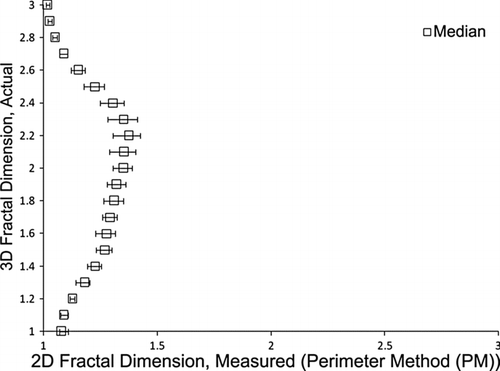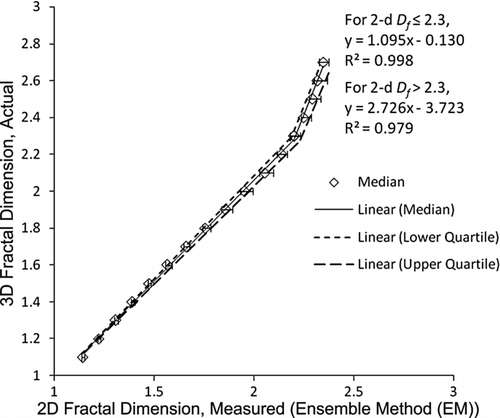Abstract
Analysis of electron microscopy images of fractal-like aggregates involves extraction of three-dimensional (3-d) structural and geometrical properties of aggregates, which are commonly unknown, from their two-dimensional (2-d) projected images. The fractal dimension Df of an aggregate is considered to be the key property for characterizing fractal-like aggregates. The nested squares method (NSM) (also known as the cumulative-intersection method and concentric circles method), the perimeter grid method (PGM), and the ensemble method (EM) have found wide use as techniques for determination of Df of both individual and ensemble aggregates in the cluster-dilute regime. However, no study has so far compared the validity and accuracy of these three most commonly used analysis methods. In this article, using the fractal simulation package FracMAP, these methods were individually tested by applying them to a statistically significant (∼2500 per fractal dimension) number of projected images of all stable orientations of computer-generated 3-d fractal aggregates with Df ranging between 1.0 and 3.0 in increments of 0.1. Results show that of the three methods, the only method that can be used to reliably determine Df from 2-d images is the EM. Both the NSM and the PGM yield many overlapping values of 2-d Df for differing values of 3-d Df resulting in a non-one-to-one relationship and large margins of error. A correction factor has been formulated as a piece-wise function of linear functions for calibrating EM measured values of 2-d Df to actual 3-d Df values.
1. Introduction
Aggregates are usually formed in high temperature combustion processes, and are of importance for a wide range of industrial applications and in the environment. Combustion-generated aggregates (e.g., soot, titanium dioxide) are usually composed of primary particles (monomers) as repeating units that coagulate to form irregular-shaped clusters. Because of their formation mechanism being governed by complex aggregation processes these aggregates exhibit complex geometry. The seminal work of Forrest and Witten (Citation1979) opened a new area of study in the field of aggregate morphology. Within a certain length scale, they characterized aggregates of metal smoke as quasi mass fractals; that is, the number of primary particles per aggregate, N, scales with the radius of gyration, Rg , as:
Analysis of electron microscopy images involves extraction of the unknown three-dimensional (3-d) structural and geometrical properties of aggregates from their two-dimensional (2-d) projected images. Among the different aggregate properties, most past studies have considered the fractal dimension Df to be the key property characterizing fractal-like aggregates (Cai et al. Citation1993; Friedlander 2000; Köylü et al. Citation1995; Oh and Sorensen Citation1997). There are several approaches to determine the fractal dimension of aggregates from their 2-d projection (as seen in a TEM/SEM image). In the course of time, the nested squares method (NSM) (also known as the cumulative-intersection method and concentric circles method), the perimeter grid method (PGM), and the ensemble method (EM) have found wide use as techniques for determination of 2-d fractal dimension for both individual and ensemble aggregates (Friedlander 2000; Samson et al. Citation1987). The past three decades have seen researchers use one or all of these three techniques to determine Df of aerosol aggregates in the cluster-dilute regime. Cluster-dilute refers to the average aggregate-aggregate separation being much larger than the aggregate size (Dhaubhadel et al. Citation2006). McDonald and Biswas (Citation2004) analyzed aggregates with aerodynamic diameter ⩽2.5 μm captured on different days via size-independent electrostatic precipitation at two sites in St. Louis, Missouri (USA) using both the NSM and the PGM. Their NSM analysis yielded Df between 1.39 and 1.89, while their PGM analysis yielded Df between 1.66 and 1.83. Park et al. (Citation2004) calculated the Df of mobility-classified diesel exhaust particles using the EM. Their analysis yielded Df = 1.75 after accounting for the effect of primary particle (monomer) overlap in the 2-d TEM images. Xiong and Friedlander (Citation2001) calculated the 2-d Df of ultrafine (aerodynamic diameter smaller than 0.1 μm) ambient aerosols collected on an eight-stage low-pressure impactor using the NSM. They reported that the 2-d fractal dimension increased from 1 to 2 as the number of primary particles increased from 10 to 180. Using the same methodology, Katrinak et al. (Citation1993) found ambient aerosols in Phoenix in the aerodynamic diameter range of 0.1-2.6 μm to yield 2-d Df ranging between 1.35 to 1.89. Dye et al. (Citation2000) calculated the 2-d Df of fine urban aerosols (aerodynamic diameter <0.1 μm) close to and far away from a road using the NSM, and found that the average 2-d Df was the same in both locations (Df = 1.56 and 1.57, respectively). Samson et al. (Citation1987) applied the NSM to soot aggregates in the cluster-dense regime (aerodynamic diameter range of 5.5–38 μm) and found their 2-d Df between 1.75 and 1.95, while Wentzel et al. (Citation2003), found the 2-d Df for cluster-dilute diesel soot aggregates to be ranging between 1.44
and 1.55.
It is worthwhile mentioning that aggregates do not fulfill the definition for fractals in a strict mathematical sense, and hence the terms “quasi mass fractal” and “fractal-like” are used. However, in all or most of the studies involving fractal analysis of aggregates, it has been assumed that the fractality of the aggregates is conserved between 2 and 3 dimensions within a certain length scale (i.e., between the monomer diameter and the aggregate radius of gyration). In other words, the assumption is that the 2-d Df equals the 3-d Df . However, a number of studies (Brasil et al. 1999, Citation2000; Lee and Kramer Citation2004) have hypothesized that factors like orientation of aggregates in the image, location of their center of mass, and the distribution of the primary particles around the center of mass could cause systematic differences between the 3-d Df and the 2-d Df determined from a 2-d projection of the 3-d structure.
The process of collecting aggregates onto electron microscopy filters commonly results in aggregates reaching a stable resting position with multiple contact points on the filter surface. It has been shown that, compared to a suspended aggregate, the projected area and length can be overestimated in the 2-d projection depending on the resting position of the aggregate and how many contact points the aggregate has established with the substrate (Brasil et al. 1999). According to Tence et al. (Citation1986), the NSM systematically underestimates the 3-d Df due to the finite size of the aggregates. The magnitude of this difference is about 0.3 for aggregates with a 3-d Df close to 2. So far, the errors involved in estimating the 3-d Df with the three most commonly used 2-d analysis techniques (i.e., NSM, EM, and PGM) have not been quantified. In this study, we analyze the errors associated with characterizing the 3-d Df through measurement of the 2-d Df with each of these three fractal analysis techniques, and put forth a recommendation on the most reliable 2-d analysis technique for the determination of 3-d Df .
The article begins with a description of the numerical simulation procedure for the generation of fractal-like aggregates. The aforementioned techniques—the NSM, the EM, and the PGM are then used to fully characterize the fractal dimension of a population of aggregates, followed by a comprehensive investigation of relationships between the actual and projected fractal dimensions of the aggregates.
2. Methods and Analysis
The simulation package, FracMAP (Chakrabarty et al. 2008, Citation2009), was used for characterizing orientation-specific 2-d Df dimension of 3-d fractal aggregates collected on filter media. The simulation method involves generating a 3-d fractal aggregate by the particle-cluster aggregation technique with a sequential algorithm that satisfies Equation (Equation1) intrinsically. For pre-specified values of Df and k 0, the aggregate generation process is initiated by randomly attaching two monomers to each other, followed by the controlled addition of further monomers to the cluster at specific positions fulfilling the following conditions: (1) the monomers do not intersect, i.e., they make point contact, and (2) the radius of gyration of the new aggregate (calculated based on the known positions of the monomers) satisfies Equation (Equation1) for the fractal dimension and prefactor selected. This process is repeated until a preselected monomer number or radius of gyration is reached. To relate the structure of such 3-d fractal aggregates to the projected 2-d images as seen by TEM/SEM, the program assumes a noisy surface (emulating the non-smooth surface of a TEM/SEM filter) and identifies likely resting orientations of the fractal on the filter surface, where its center of mass rests above an area defined by the possible contact points of the fractal. For all the valid orientations, a pixilated 2-d projection is generated and analyzed for its projected properties.
For this particular study, 3-d fractal aggregates were generated with Df ranging from 1.0 to 3.0 in increments of 0.1. The prefactor was set at 1.19 for all fractals as recommended by Sorenson and Roberts (1997). For each Df , at least one hundred aggregates were generated with the monomer number chosen randomly between 10 and 500 for each aggregate. Each aggregate generated was oriented into 25 random orientations, and the stable orientations on the filter that were closest to these random orientations were found. Once the aggregates were in stable orientations, the fractal projection was obtained as a 2-d pixilated image, and the 2-d fractal analyses techniques described in the next paragraph were applied to this image. Thereby, for each Df at least 2500 oriented aggregates were used when comparing actual 3-d attributes with measured attributes of projected images. The resulting data was characterized using median values and lower and upper quartile designations rather than conventional means and standard deviations because for certain methods there was heavy skewing of values and outliers on either side of the mean.
2.1. The Nested Squares Method (NSM)
Calculating Df with the NSM technique involves drawing boundaries (e.g., squares or circles) of increasing size upon a 2-d, pixilated image of a fractal aggregate centered on the aggregate center of mass. For every boundary, the number of pixels occupied by the particle is counted. The 2-d Df is calculated as the linear regression slope of the linear portion of the log-log curve generated by plotting boundary size against pixel count.
2.2. The Perimeter Grid Method (PGM)
Calculating Df with the PGM is done by drawing grids of differing box sizes upon a 2-d image of a fractal aggregate. Given a grid with a certain box size, the number of grid boxes through which the perimeter passes is counted. A grid with a different box size is then drawn, and the number of grid boxes through which the perimeter passes is counted once again. This process is repeated, and the logarithm of the box size plotted against the logarithm of the box count, providing the perimeter fractal dimension as slope.
2.3. The Ensemble Method (EM)
Calculating Df with the EM involves using the relationship expressed by Equation (Equation1) and determining the values for the number of monomers N, the radius of gyration Rg , the average monomer diameter dp , and the prefactor k 0. Given a pixelated, 2-d image of a fractal aggregate, average monomer diameter must be measured or be known (as for computer simulated particles). The number of monomers is the ratio of the pixelated area and the area of a monomer. The radius of gyration is calculated from pixel coordinates using Equation (Equation2) (Chakrabarty et al. Citation2007).
3. Results and Discussion
Using the three procedures outlined in the previous section, a statistically significant (∼2500 per fractal dimension) number of stably oriented 3-d aggregates for fractal dimensions between 1.0 and 3.0 in increments of 0.1 were used for comparison of their 2-d Df with their actual 3-d Df . Brief discussions on the comparison findings for each of the three individual methods are provided in the following sub-sections.
3.1. The Nested Squares Method (NSM)
Measured values of the 2-d Df using the NSM method resulted in a sporadic relationship between inferred values for 2-d Df and actual values of 3-d Df .
shows the plot, with median values and lower and upper quartile designations, for comparison of 3-d Df versus 2-d Df calculated using the NSM method.
FIG. 1 Comparison plot, with median values and lower and upper quartile designations, for 3-d fractal dimension versus 2-d fractal dimension calculated using the Nested Squares method (NSM).
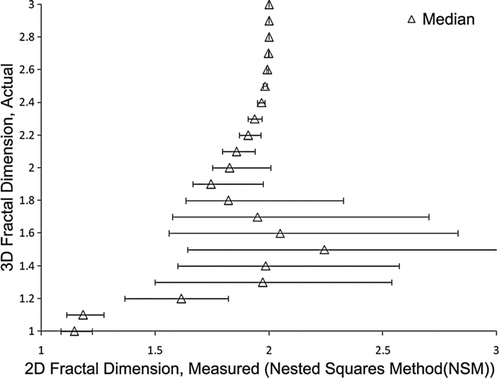
The plot of median values is not one-to-one, overlapping as many as three times for commonly observed values of 2-d Df (McDonald and Biswas Citation2004; Wentzel et al. Citation2003; Xiong and Friedlander Citation2001). Exceedingly large margins of error exacerbate the ambiguity of these measurements. For example, a measured density Df of 1.82 lies within the 25th and 75th percentiles of each real 3-d Df value examined between 1.2 and 2.1. In conclusion, the method yields results that are too erratic to be mitigated, and determining a corrective factor for the method does not appear feasible.
3.2. The Perimeter Grid Method (PGM)
shows the plot, with median values and lower and upper quartile designations, for comparison of 3-d Df versus 2-d Df calculated using the PGM method. The plot makes it apparent that there are many overlapping values of 2-d Df for differing values of 3-d Df . The values are more easily distinguishable from their neighbors for 3-d Df values closer to 1.0 or closer to 3.0. However, the values for measured 2-d Df for these ranges overlap—for 3-d Df : [1.1, 1.5] and 2-d Df : [1.08, 1.27], and for 3-d Df : [2.4, 2.9], 2-d Df : [1.31, 1.03]. Thus, any predictive applications from the resulting data of our analysis would require some form of pre-classification of fractal aggregates to determine appropriate ranges. Even with fractal pre-classification into “linear” (3-d Df closer to 1.0), “moderate,” and “dense” (3-d Df closer to 3.0) regimes, the possible 2-d Df domain is very narrow for the more frequently observed Df measurements between 1.27 and 1.38 mapping to a very broad 3-d Df range of about 1.5 to 2.3. Results from mapping this narrow domain to a broader range suffer from ambiguity caused by a non-one-to-one relationship and large margins of error associated with the method. A good example of why this is an issue is that for aggregates with 3-d Df between 1.5 and 2.2 the change in median measured 2-d Df is +0.11, whereas the difference between the 25th and 75th percentiles for a single value of 3-d Df in the range of 1.3 and 2.6 is no less than 0.06 and is even as high as 0.12—larger than our measured median difference for a very broad range—which greatly undermines the efficacy of the median measurements. In conclusion, determining a corrective factor is perhaps possible for near-linear-shaped aggregates with a 3-d Df between 1.1 and 1.5 and for compact-shaped aggregates with a 3-d Df between 2.4 and 3.0; however large margins of error are still a major issue
3.3. The Ensemble Method (EM)
The EM for inferring Df from 2-d pixilated images of projected 3-d aggregates yields highly consistent results. shows the plot, with median values and lower and upper quartile designations, for comparison of 3-d Df versus 2-d Df measured using the EM method.
FIG. 3 Comparison plot, with median values and lower and upper quartile designations, for 3-d fractal dimension versus 2-d fractal dimension calculated using the Ensemble method (EM).
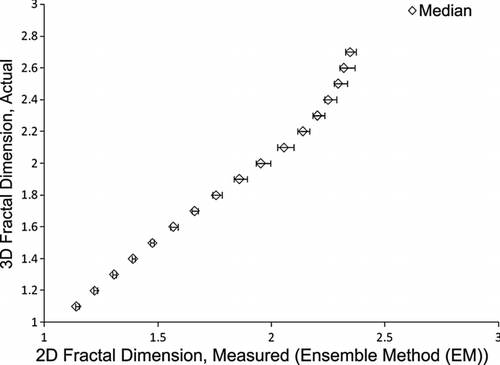
Error bars were minimal and the resulting plot of actual 3-d Df against measured median values of 2-d Df is a one-to-one relationship, lending itself to little ambiguity of inference, especially for actual values of 3-d Df between 1.1 and 2.3, a range of values that includes the most commonly observed values for Df of soot aggregates.
The EM is the only commonly used method for fractal dimension Df inference from 2-d images that results in a one-to-one relationship and maintains minimal margins of error in measurement, thereby proving itself to be the only reliable method for analysis of projected fractal-like particle aggregates. Fortunately, a correction factor for adjusting measured values of 2-d Df to their actual 3-d values can be developed with an excellent correlation between the corrected EM 2-d Df measurements and the actual 3-d values. This correction factor is provided below as a piece-wise function of linear functions.
In Equations (Equation3) and (4), the superscripts and the subscripts correspond to the difference between upper and lower quartile values and the mean ().
3.4. Anisotropic Effects on Two-Dimensional Fractal Dimension Analysis
In a recent work (Brasil et al. 1999), empirical relationships were derived between projected and actual properties of aggregates by considering the aggregates to be suspended in random, non-stability-restricted orientations. However, in reality, projected properties of aggregates are analyzed from electron microscopy images, where the aggregates reach a resting position with more than two contact points with the filter surface, henceforth referred to as a stable orientation. An analysis using the EM was done comparing stable versus random orientations of simulated 3-d fractal aggregates. The “random” set was generated by randomly orienting generated particles prior to taking the 2-d projected image. Stable orientations were determined for the aggregates as they would rest on filter media, common to in situ analysis such as with scanning and transmission electron microscopy. Regardless of orientation scheme, measurements of median values for predicted Df using EM against actual 3-d Df are similar. However, accounting for aggregate stability did reduce the “margin of error”—as measured by the difference between the 75th and 25th percentiles—by an average of 346% for measured values of Df between 1.14 and 2.20 and by as much as 724% ().
FIG. 5 Plot of the difference between the 75th and 25th percentiles for measured 2-d fractal dimension using the Ensemble Method (EM) for both stable and unstable aggregate orientations against actual 3-d fractal dimension.
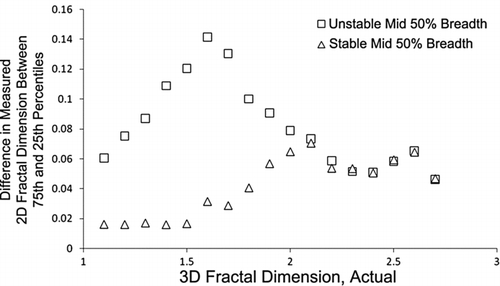
This greatly increases the accuracy of measurements and reduces the uncertainty in the correction factor.
4. Conclusions
This article systematically compares the validity and accuracy of the three most commonly used 2-d fractal dimension analysis methods for aggregates—the NSM, the PGM, and the EM. These methods were individually tested by applying them to a statistically significant number of projected images (∼50,000 total or 2500 per fractal dimension) of all stable orientations of computer-generated 3-d fractal aggregates with Df ranging between 1.0 and 3.0 in increments of 0.1. The simulation package, FracMAP (Chakrabarty et al. 2008, Citation2009), was used for generating 3-d fractal aggregates by the particle-cluster aggregation technique, and then characterizing the 2-d Df of the projected images for all possible stable orientations of the 3-d fractal aggregates using the aforementioned three analysis techniques.
Of the three methods studied, the only method that can be used to reliably determine Df from 2-d images is the EM. Comparison study using the EM shows a one-to-one relationship between the 2-d and 3-d Df with minimal margins of error involved. A correction factor has been formulated as a piece-wise function of linear functions for calibrating EM measured values of 2-d Df to actual 3-d Df values. Using the NSM yielded exceedingly large margins of error, thereby making it almost impossible to determine a corrective factor for the method, while using the PGM resulted in many overlapping values of 2-d Df for differing values of 3-d Df resulting in a non-one-to-one relationship and large margins of error.
We hypothesize that the imprecise measurements of Df by NSM and PGM are due to the “non self-similar” property of aerosol aggregates and their 2-d images. By definition, a true fractal has a morphology that possesses “self-similarity” (i.e., that the basic ‘repeating unit’ of the contour of a fractal object appears similar under any magnification). However, the shape of detail observed for a cluster-dilute aerosol aggregate is not similar under all magnifications; self-similarity breaks down as the length scale approaches the monomer size. In other words, the shape of the aggregate contour and its constituent parts (monomers) is not the same. This breakdown of the “self-similar” property is not distinguished by the NSM and PGM techniques. Under high magnification, neither technique assumes the repeating unit of an aggregate image to be a monomer. As a result, when applying these techniques, the data points obtained by drawing smaller boundaries (e.g., squares or circles) of increasing size on the image centered on the aggregate's center of mass are usually false measurements of textural and structural fractal dimensions (previously described as “fractal rabbits” (Kindratenko et al. Citation1994)), which in turn affect the overall slope (Df ) of the log-log plot of the image. However, it is to be noted here that the PGM technique has been shown to correctly measure the actual Df of superaggregates (aggregate of aggregates) in the cluster-dense regime (Dhaubhadel et al. Citation2006). In the case of superaggregates, the repeating unit being an aggregate under higher magnification, the PGM technique does not have to deal with the “self-similarity” breakdown limitation. The EM technique, on the other hand, remedies the “self-similarity” breakdown limitation in the cluster-dilute regime by accounting for a monomer as a repeating unit over the entire length scale of an aggregate. This plausibly explains why the 2-d Df measured using the EM technique comes closest to predicting the actual 3-d Df of an aerosol aggregate. Further work needs to be done to determine correction factors for the EM technique when applied to aggregates with “necking” monomers (Oh and Sorensen Citation1997) and while varying aggregate properties, such as prefactor ko , monomer diameter, and monomer number. Additionally, the apparent overlap between monomers in a 2-d image needs to be investigated for all techniques. To summarize, we recommend the use of the EM technique for reliably determining aggregate 3-d Df from 2-d images.
Acknowledgments
This material is based upon work supported by NASA ESPCoR under Cooperative Agreement No. NNX10AR89A, by the National Science Foundation under Cooperative Support Agreement No. EPS-0814372, and by the Desert Research Institute. Christopher Herald was partially supported by NSF Grant DMS 0709625. The authors also would like to thank Dr. Christopher Sorensen and his research group at the Kansas State University, Dr. Peter McMurry (Editor-in-Chief of Aerosol Science and Technology), and two anonymous reviewers for their helpful suggestions.
REFERENCES
- Brasil , A. M. , Farias , T. L. and Carvalho , M. G. 2000 . Evaluation of the Fractal Properties of Cluster-Cluster Aggregates . Aerosol Sci. Technol. , 33 : 440 – 454 .
- Brasil , A. M. , Farias , T. L. and Carvalho , M. G. 1999 . A Recipe for Image Characterization of Fractal-Like Aggregates . J. Aerosol Sci. , 30 : 1379 – 1389 .
- Cai , J. , Lu , N. and Sorensen , C. M. 1993 . Comparison of Size and Morphology of Soot Aggregates as Determined by Light-Scattering and Electron-Microscope Analysis . Langmuir , 9 : 2861 – 2867 .
- Chakrabarty , R. K. , Garro , M. A. , Chancellor , C. , Herald , C. and Moosmüller , H. 2009 . FracMAP: A Graphical User-Interactive Package for Performing Simulation and Morphological Analysis of Fractal-Like Aerosol Agglomerates . Comput. Phys. Commun. , 180 : 1376 – 1381 .
- Chakrabarty , R. K. , Garro , M. A. , Herald , C. and Moosmüller , H. 2008 . A User-Interactive Package for Performing Simulation and Orientation-Specific Morphology Analysis of Solid Nano-Agglomerates. United States Patent pending
- Chakrabarty , R. K. , Moosmüller , H. , Arnott , W. P. , Garro , M. A. , Slowik , J. G. , Cross , E. S. , Han , J.-H. , Davidovits , P. , Onasch , T. B. and Worsnop , D. R. 2007 . Light Scattering and Absorption by Fractal-Like Carbonaceous Chain Aggregates: Comparison of Theories and Experiment . Appl. Opt. , 46 : 6990 – 7006 .
- Dhaubhadel , R. , Pierce , F. , Chakrabarti , A. and Sorensen , C. M. 2006 . Hybrid Superaggregate Morphology as a Result of Aggregation in a Cluster-Dense Aerosol . Phys. Rev. E , 73 : 011404 – 011401 .
- Dye , A. L. , Rhead , M. M. and Trier , C. J. 2000 . The Quantitative Morphology of Roadside and Background Urban Aerosol in Plymouth, UK . Atmos. Environ. , 34 : 3139 – 3148 .
- Farias , T. L. , Carvalho , M. G. , Koylu , U. O. and Faeth , G. M. 1995 . Computational Evaluation of Approximate Rayleigh-Debye-Gans/Fractal-Aggregate Theory for the Absorption and Scattering Properties of Soot . J. Heat Transfer-Transactions of the ASME , 117 : 152 – 159 .
- Forrest , S. R. and Witten , T. A. 1979 . Long-Range Correlations in Smoke-Particle Aggregates . J. Physics A—Mathematical and General , 12 : L109 – L117 .
- Friedlander , S. K. 2000 . Smoke, Dust, and Haze: Fundamentals of Aerosol Dynamics. , New York : Oxford University Press .
- Katrinak , K. A. , Rez , P. , Perkes , P. R. and Buseck , P. R. 1993 . Fractal Geometry of Carbonaceous Aggregates from an Urban Aerosol . Environ. Sci. Technol. , 27 : 539 – 547 .
- Kindratenko , V. V. , Vanespen , P. J. M. , Treiger , B. A. and Vangrieken , R. E. 1994 . Fractal Dimensional Classification of Aerosol-Particles by Computer-Controlled Scanning Electron-Microscopy . Environ. Sci. Technol. , 28 : 2197 – 2202 .
- Köylü , Ü. Ö. , Faeth , G. M. , Farias , T. L. and Carvalho , M. G. 1995 . Fractal and Projected Structure Properties of Soot Aggregates . Combust. Flame , 100 : 621 – 633 .
- Lee , C. and Kramer , T. A. 2004 . Prediction of Three-Dimensional Fractal Dimensions using the Two-Dimensional Properties of Fractal Aggregates . Adv. Colloid Interface Sci. , 112 : 49 – 57 .
- McDonald , R. and Biswas , P. 2004 . A Methodology to Establish the Morphology of Ambient Aerosols . J. Air Waste Manage. Assoc. , 54 : 1069 – 1078 .
- Oh , C. and Sorensen , C. M. 1997 . The Effect of Overlap between Monomers on the Determination of Fractal Cluster Morphology . J. Colloid Interface Sci. , 193 : 17 – 25 .
- Park , K. , Kittelson , D. and McMurry , P. 2004 . Structural Properties of Diesel Exhaust Particles Measured by Transmission Electron Microscopy (TEM): Relationships to Particle Mass and Mobility . Aerosol Sci. Technol. , 38 : 881 – 889 .
- Samson , R. J. , Mulholland , G. W. and Gentry , J. W. 1987 . Structural Analysis of Soot Agglomerates . Langmuir , 3 : 272 – 281 .
- Sorensen , C. M. 2001 . Light Scattering by Fractal Aggregates: A Review . Aerosol Sci. Technol. , 35 : 648 – 687 .
- Sorensen , C. M. and Roberts , G. C. 1997 . The Prefactor of Fractal Aggregates . J. Colloid Interface Sci. , 186 : 447 – 452 .
- Tence , M. , Chevalier , J. P. and Jullien , R. 1986 . On the Measurement of the Fractal Dimension of Aggregated Particles by Electron-Microscopy—Experimental-Method, Corrections and Comparison with Numerical-Models . J. Phys. , 47 : 1989 – 1998 .
- Wentzel , M. , Gorzawski , H. , Naumann , K.-H. , Saathoff , H. and Weinbruch , S. 2003 . Transmission Electron Microscopical and Aerosol Dynamical Characterization of Soot Aerosols . J. Aerosol Sci , 34 : 1347 – 1370 .
- Xiong , C. and Friedlander , S. K. 2001 . Morphological Properties of Atmospheric Aerosol Aggregates . Proc. Natl. Acad. Sci. U. S. A. , 98 : 11851 – 11856 .
